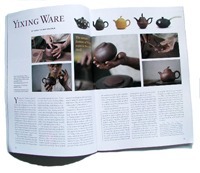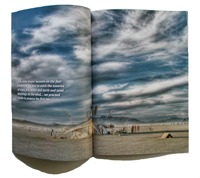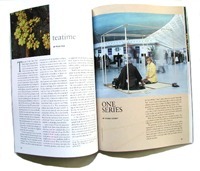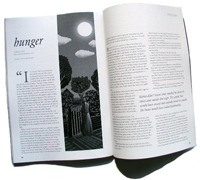Kyoto Journal #71 featured my short story "Hunger"
Kyoto Journal #71 brought together diverse writers celebrating the varied aspects of tea. My short story "Hunger" was also published in it.
You can view their content page below.
___________________________________________________________________________
Here’s a sampling of voices from the vibrant, pervasive, evolving world of tea, from a wide variety of sources, The story of tea is a perfect lens through which to view the contact and mutual transformation of East and west. This is barely an introduction, but the many trails are marked.
This issue was guest edited by Gaetano Kazuo Maida, executive director of the nonprofit Tea Arts Institute, former organizer of the American Premium Tea Institute and publisher of the industry journal Tea Trade. (He is also a founding director of the Buddhist magazine Tricycle, and is executive director of the International Buddhist Film Festival, www.ibff.org.) The Art Director of this issue is Ayelet Maida, principal of A/M Studios, and creative director of the International Buddhist Film Festival. Contributing Editors: Lauren W. Deutsch, Josh Michaell and Winnie Yu.
Contents:
BAISAO: THE OLD TEA SELLER –
At a time when the word “tea” for most Japanese still meant powdered matcha, Baisao was serving a new variety that came to be known in Japan as sencha, a word that translates literally as “simmered tea.”
DARJEELING –
Darjeeling is bound to its reputation as the “Champagne of teas.” The 87 Darjeeling tea gardens form the tea equivalent of a French wine appellation. A hectare of Darjeeling bush will yield a mere 500 kilos of tea each year.
YIXING WARE –

VERANDAH –
Installation and story
TEA AT SHAOLIN –
“When new monks at Shaolin ask me about the Dharma, I tell them to have a cup of tea. If they still don’t understand, I tell them to taste the tea. The Way is in everything we do. Drinking a cup of tea, eating, shitting, it doesn’t matter, it’s all the Way. You can read all the books you want, but unless you find the Way in your daily life, you’re wasting your time.”
MING HORSES, TEA AND THE THIRD DALAI LAMA –
In the same year that Tibetan authorities agreed to the Mongolian entitlement of the Dalai Lama, the Chinese granted official permission to Mongolians to trade in tea. In the fall of 1577, tea was for the first time officially sold by China to the Mongolians.
TEMPLE OF TEA, TEMPLE OF THIRST –

UJI GREEN –
The concentrated flavor of gyokuro is sweet, fresh, thick and rounded. Protecting the new leaves from the sun’s rays enhances the production of theanin, an amino acid that’s the source of tea’s natural sweetness.
TEATIME –

Within the tearoom itself, every detail sang the shifting of the seasons. The poem in the tokonoma alcove spoke of hearts resembling the autumn moon. An incense holder reproduced the circle of the harvest moon. The seven autumn grasses poked, haphazardly elegant, out of a long-necked vase.
ONE SERIES –
Tea ceremony as portable public performance art
LANDSCAPE –
The “Song of Tea” is one of the most beloved poems known by tea-drinkers the world over. Its verses on “seven cups” of tea remain as famous today as when written in China during the T’ang dynasty (618–906 AD).
Take-out tea with a whole new meaning
YUN WEI –
PU-ER BY
Unlike any other tea, pu-er is designed to be aged for years after it’s picked, and is regarded almost as a living being, with personality. It displays one set of characteristics when young and continues to mature and change as time passes; as with people, the environment in which it “grows up” affects the way it matures.
SRI LANKA PILGRIMAGE –
CHA –
For the Chinese understand that without nature, man is inherently insignificant. It is therefore understandable that of all of the thousands of teas in China, none were specifically named after a person, not even after any of the many emperors who were often responsible for naming them. Most individual teas are named after their places of origin, the most common being the mountains where many are found.
HUMILITY –
THE GAIWAN –
The gaiwan is also called the Three Marvels Bowl, for Heaven, Earth, and Man. The lid is on top, therefore heaven, the saucer supports everything, therefore earth, and living between heaven and earth is mankind, and therefore, the bowl.
ADVENTURES IN THE TEA TRADE – TEA MERCHANTS WINNIE YU AND SEBASTIAN BECKWITH
29 Moguk, Burma
63 Phoenix Mountain, China; Wuyi, China
76 Treasure Mountain, Anxi, China
77 Darjeeling, India; Tung Ting, Taiwan
78 Taiping, China; Wenshan, Taiwan
79 Phongsali, Laos
63 Phoenix Mountain, China; Wuyi, China
76 Treasure Mountain, Anxi, China
77 Darjeeling, India; Tung Ting, Taiwan
78 Taiping, China; Wenshan, Taiwan
79 Phongsali, Laos
IN REVIEW
Lauren W. Deutsch on Tan Dun’s opera Tea: A Mirror of Soul
Josh Michaell on The Modern Japanese Tea Room, by Michael Freeman, and Contemporary Teahouses in China
Lauren W. Deutsch on Americans Studying the Traditional Japanese Art of the Tea Ceremony: The Internationalizing of a Traditional Art, by Barbara Mori
Josh Michaell on All In This Tea, directed by Les Blank and Gina Liebrecht
Lauren W. Deutsch on The Ancient Tea Horse Road: Travels with the Last of the Himalayan Muleteers, by Jeff Fuchs [Errata: P.54, second column, second par “…Fuchs recalls” should read: “In a distant echo of news from the first caravans, he recalls…” – “he” refers to Jason Rush.]
Josh Michaell on The Time of Tea, by Dominique Pasqualini and Bruno Suet
Josh Michaell on The Modern Japanese Tea Room, by Michael Freeman, and Contemporary Teahouses in China
Lauren W. Deutsch on Americans Studying the Traditional Japanese Art of the Tea Ceremony: The Internationalizing of a Traditional Art, by Barbara Mori
Josh Michaell on All In This Tea, directed by Les Blank and Gina Liebrecht
Lauren W. Deutsch on The Ancient Tea Horse Road: Travels with the Last of the Himalayan Muleteers, by Jeff Fuchs [Errata: P.54, second column, second par “…Fuchs recalls” should read: “In a distant echo of news from the first caravans, he recalls…” – “he” refers to Jason Rush.]
Josh Michaell on The Time of Tea, by Dominique Pasqualini and Bruno Suet
REGULAR FEATURES
FICTION
HUNGER –

POETRY
TWO POEMS IN PRAISE OF ENKA –
FOUR POEMS BY
Translated by Brother Anthony of Taizé and Lee Hyung-Jin
IN TRANSLATION
THE WRONG PARADISE –





Comments